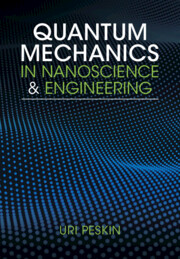Book contents
- Quantum Mechanics in Nanoscience and Engineering
- Additional material
- Quantum Mechanics in Nanoscience and Engineering
- Copyright page
- Contents
- Preface: Who Can Benefit from Reading This Book?
- 1 Motivation
- 2 The State of a System
- 3 Observables and Operators
- 4 The Schrödinger Equation
- 5 Energy Quantization
- 6 Wave Function Penetration, Tunneling, and Quantum Wells
- 7 The Continuous Spectrum and Scattering States
- 8 Mechanical Vibrations and the Harmonic Oscillator Model
- 9 Two-Body Rotation and Angular Momentum
- 10 The Hydrogen-Like Atom
- 11 The Postulates of Quantum Mechanics
- 12 Approximation Methods
- 13 Many-Electron Systems
- 14 Many-Atom Systems
- 15 Quantum Dynamics
- 16 Incoherent States
- 17 Quantum Rate Processes
- 18 Thermal Rates in a Bosonic Environment
- 19 Open Quantum Systems
- 20 Open Many-Fermion Systems
- Index
- References
11 - The Postulates of Quantum Mechanics
Published online by Cambridge University Press: 11 May 2023
- Quantum Mechanics in Nanoscience and Engineering
- Additional material
- Quantum Mechanics in Nanoscience and Engineering
- Copyright page
- Contents
- Preface: Who Can Benefit from Reading This Book?
- 1 Motivation
- 2 The State of a System
- 3 Observables and Operators
- 4 The Schrödinger Equation
- 5 Energy Quantization
- 6 Wave Function Penetration, Tunneling, and Quantum Wells
- 7 The Continuous Spectrum and Scattering States
- 8 Mechanical Vibrations and the Harmonic Oscillator Model
- 9 Two-Body Rotation and Angular Momentum
- 10 The Hydrogen-Like Atom
- 11 The Postulates of Quantum Mechanics
- 12 Approximation Methods
- 13 Many-Electron Systems
- 14 Many-Atom Systems
- 15 Quantum Dynamics
- 16 Incoherent States
- 17 Quantum Rate Processes
- 18 Thermal Rates in a Bosonic Environment
- 19 Open Quantum Systems
- 20 Open Many-Fermion Systems
- Index
- References
Summary
We review the postulates of quantum mechanics with respect to the representation of physical states and measurable quantities, their time evolution, and the interpretation of measurements. We first formulate the postulates in terms of wave functions and differential operators, and then reformulate them in the abstract Hilbert space of state vectors, using Dirac’s notations. Improper states subject to Dirac’s delta normalization are introduced, and the space of physical states is extended to include them. The postulates are rationalized by associating each Hermitian linear operator with a complete orthonormal system of its eigenvectors, where measurement probabilities depend on the projections of these eigenvectors on the system’s state vector. Particularly, wave functions are identified as projections of state vectors on the position operator eigenstates. State vectors representing multidimensional systems are formulated as tensor products of vectors in their subspaces. Finally, we address the general uncertainty relations in simultaneous measurements of different observables.
Keywords
- Type
- Chapter
- Information
- Quantum Mechanics in Nanoscience and Engineering , pp. 122 - 154Publisher: Cambridge University PressPrint publication year: 2023

